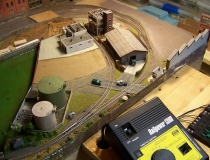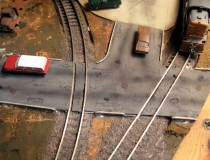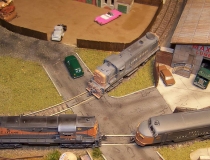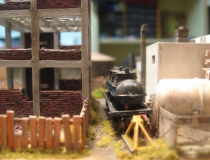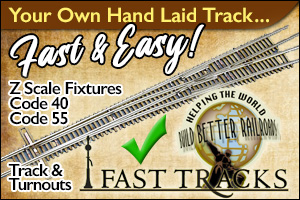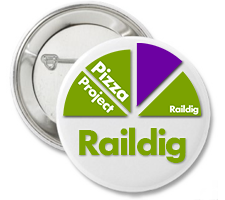Searching The Floor

By John Bartolotto
I’ve been a modeler most of my life in one capacity or another. Model soldiers, cars, ships, planes, military vehicles and of course trains.
Model trains however have been my focus for the past thirteen years as has my on again / off again love affair with Z scale. Z scale has its pros and cons as with any scale, its size of course being the main dual edge sword of both benefit and frustration. Its size is what drew me to it in 1999 just because I just thought it was “cool”, no other reason except how cool it was to see such tiny model trains (I was modeling in N scale at the time). Its size is what made me leave it in 2007 because of the frustration I was experiencing trying to model the New York Central and Hudson River Rail Road (NYC&HRRR) circa 1890 – it became a huge challenge since not much is available in Z for that era of early steam so I moved on to N scale.
Its size is what drew me back to it in 2009 because I was moving to a new house and my new “hobby room” (the furnace room in the basement) was smaller than the one my N scale layout occupied. My N scale layout wouldn’t fit in the new room so if I wanted to stay in the model railroad hobby I needed an option. The size of Z presented the perfect solution because I could do so much with it in a small area thereby it fit nicely into my new hobby room. Furthermore, this time I was modeling the Long Island Rail Road (LIRR) circa 1960s meaning there were many more items prevalent and readily available in Z. So here I am, modeling the LIRR circa 1960s in Z scale. “That’s nice John.”
In all my modeling adventures, I have tried to be accurate enough in order to get the “feel” of what I am trying to portray in my modeling.
This is both a blessing and a curse. A blessing because I can readily use real life to present me with life’s gritty examples and a curse because I spend a lot of time researching those examples and then of course detailing scenes to get to my happy place of “accurate enough”.
Achieving “accurate enough” in the world of Z model railroading to me means that I usually have to modify, kit-bash and/or scratch build items, all of which I really like to do because I plainly like challenges, but this is further challenging in the small world of Z.
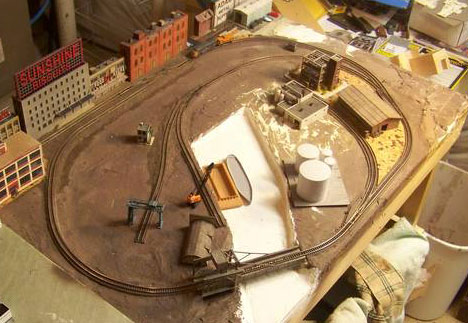
John’s Long Island Railroad Inspired Layout
Once more Z’s size comes into play and working with small Z detail parts inevitably leads to “the event”. No matter how hard I try to prevent “the event” from occurring in the course of my detailing quest it happens just the same, like the Grinch trying to stop Christmas from coming, it comes all the same, and it happens at least once each modeling session. The event? The flying small part! I have lost count how many times I have gotten down on my hands and knees with a flashlight searching the floor for a wayward 1/220 scale part. My years of modeling all sorts of items did prepare me in a way I guess that I have been able (lucky is probably a better word) to closely figure out the landing place of flying parts. I am not expert in this area because numerous parts are still missing in action, most of which are probably eventually captured by my wife in all her good-hearted nature when she voluntarily vacuums my hobby room floor. But I have become pretty good at tracking the wild flying part. “Snap! Follow it, follow it!”
Trajectory! Think like the part. Do I need to compensate for possible ricocheting off anything? Where would I land if I was a Z scale car door flying through the air set forth in motion by the pressure of a finger exerted on an X-Acto knife? Nothing. Darn! Get the flashlight and glasses out to search the floor. It becomes a search and rescue scene from “Honey I Shrunk the Kids”, making sure that I carefully move myself from my chair so as not to disturb where the part maybe lying in wait for me to find it. The great 1/220 scale hide and seek game is on!
I wonder if there is a mathematical calculation to figure out if you apply a certain force to a Z scale item how far it will fly and in what direction it would land? Probably not. I have found that to be even partially successful in this area you need a good flashlight (I prefer Mag-Lites), reading glasses (in some cases a good magnifier visor) and a lot of patience. Now unless the part is really important or one of a kind then patience to me means that I don’t spend more than five minutes looking for it (of course it seems lot longer than that when I am on my hands and knees searching the nooks and crannies of my old hobby room carpet). This is the part of Z modeling and modeling in general that I will never enjoy or get used to. Sometimes I wish I recorded my modeling sessions so that I could review the film footage like an instant replay to find where those parts have flown off. One thing to repeat to yourself as you are searching the floor is the calming quote of “I love my hobby! I love my hobby!”
Even with these flying challenges, I will still model and still continue to model in Z (as long as my eyes, hands and knees can hold out) probably because I really do love this hobby of model railroading. If you get the time and would like to see all the parts that didn’t fly away on me and those that I found you can follow my LIRR Z scale adventure at the TrainBoard Z scale forum: Long Island Railroad In Z Scale.
John Bartolotto
John Bartolotto was born and raised on Long Island, NY and has been a US Army Officer since 1983 with half of his career served in Germany. He is currently a Colonel stationed in the Pentagon. He is the founder of Nansen Street Models and models both in N and Z scales.
Category: Raildig Guest




